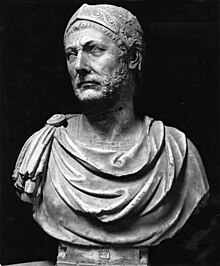
Back Hannibal Afrikaans Hannibal ALS ሃኒባል Amharic Aníbal Barca AN Hannibal ANG حنبعل Arabic هانيبال ARZ Aníbal AST Hannibal Azerbaijani Һаннибал Bashkir
| Hannibal | |
|---|---|
 | |
| Born | 247 BC Carthage |
| Died | 183, 182 or 181 BC (aged 64-66) Libyssa |
| Allegiance | Carthage |
| Rank | General, commander-in-chief of the Carthaginian armies |
| Battles/wars | Siege of Saguntum Battle of Ticinus Battle of Trebia Battle of Lake Trasimene Battle of Cannae Battle of the Silarus Battle of Herdonia Battle of Zama |
Hannibal (Hǎnnibal Barca, 247 BC – ? 183/2/1 BC), was a Carthaginian statesman and general who was the greatest enemy of the Roman Republic.
Hannibal is most famous for what he did in the Second Punic War. He marched with an army from Iberia over the Pyrenees and the Alps into northern Italy and defeated the Romans in a series of battles. At the Battle of Cannae, he defeated the largest army Rome had ever put together even though Carthage was heavily outnumbered. The Roman army at Cannae is reckoned at 16 legions and a total of 86,000 men. Over 80% of the army was killed or captured, including many of its commanders.
Hannibal kept an army in Italy for many years. Eventually, a Roman invasion of North Africa made him return to Carthage. He lost, and the Romans made him leave Carthage. He lived at the Seleucid court and convinced its emperor to fight Rome. When he lost a naval battle, Hannibal fled to the Bithynian court. When the Romans told him to surrender, he committed suicide by drinking poison.
Hannibal is listed as one of the greatest military commanders in history. The military historian Theodore Ayrault Dodge once called Hannibal the "father of strategy" because even his greatest enemy, Rome, copied his military ideas.

- ↑ Lancel, Serge 1995. Hannibal cover: "Roman bust of Hannibal. Museo Archeologico Nazionale. Naples"
- ↑ Goldsworthy, Adrian 2000. The fall of Carthage cover: "Hannibal in later life"
- ↑ Goldsworthy, Adrian 2001. Cannae p. 24: "a bust, which may be a representation of Hannibal in later life, although there are no definite images of him"
- ↑ Goldsworthy, Adrian 2003. The complete Roman Army p. 41: "a bust that purports to show Hannibal in later life"
- ↑ Matyszak, Philip 2003. Chronicle of the Roman Republic p. 95: "bust, thought to be of Hannibal, found in Capua"